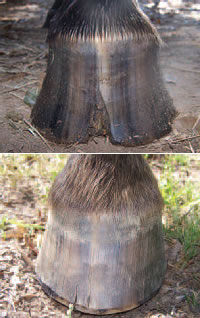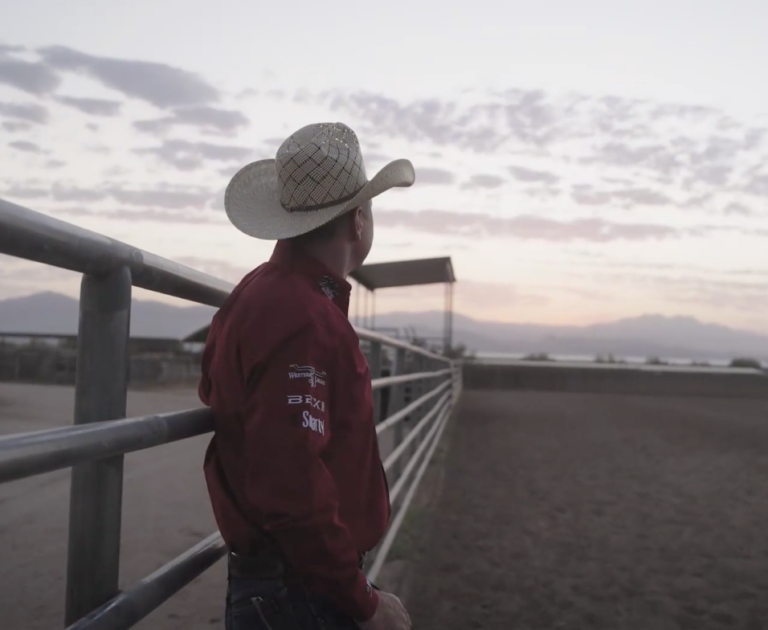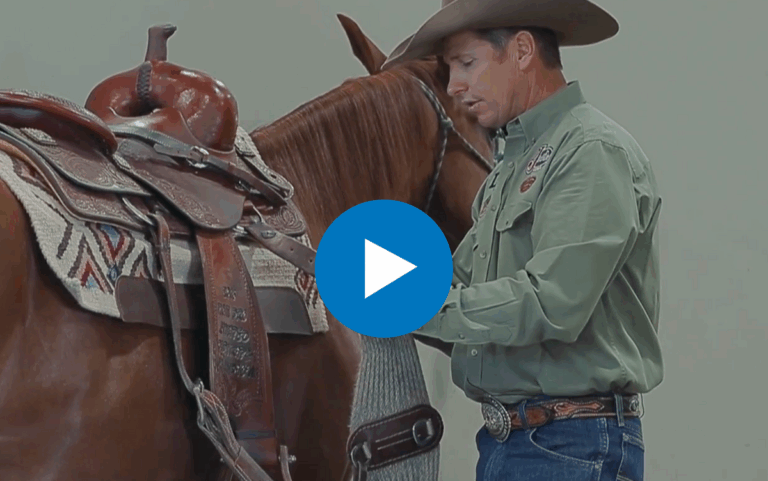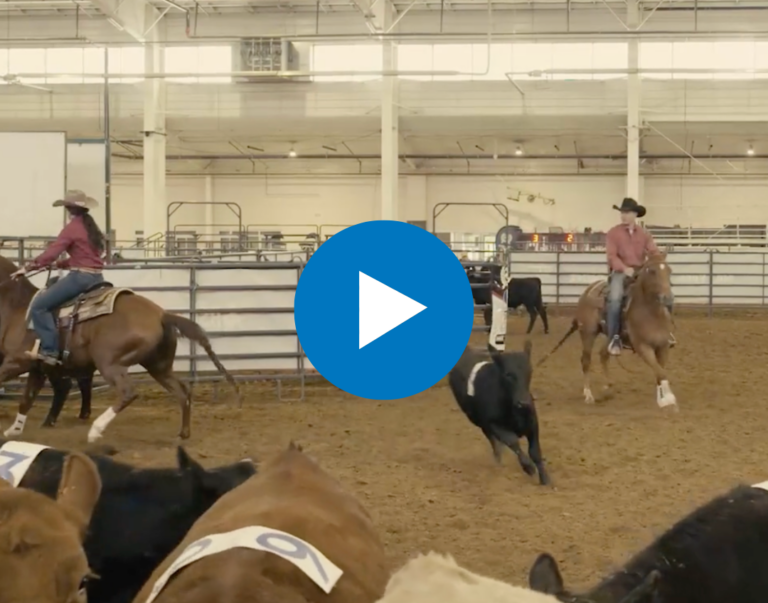Since our special report on the barefooted horse, the natural-hoof movement has continued to pick up steam. Barefooted, booted horses now dominate the world of endurance racing, where traveling at speed over rugged terrain is the norm. You can also find shoeless horses in many other lines of work and areas of competition, including Western performance.
First, let’s cover some basics with a man who’s been instrumental in driving the move toward barefootedness: Pete Ramey, one of the world’s most experienced and respected natural hoof-care practitioners. A farrier since 1994, Ramey became intrigued in 1998 by what he was hearing about the overall health benefits of going barefoot. Once he started using the specialized trim modeled after the wear patterns of horses in the wild, he began to see its value in hoof rehabilitation, which has become his specialty.
Today, he advocates a holistic approach that includes feeding and exercise in addition to the barefoot trim. The horses he works on often are those deemed beyond hope by veterinarians and conventional farriers. Literally hundreds of horses suffering the effects of founder and navicular disease have been returned to health by the methods he advocates.
A much-sought-after clinician, Ramey has a 10-disc DVD series, “Under the Horse,” which features both classroom instruction and live trimming. The series is in keeping with his goal of educating as many people as possible–owners and hoof care practitioners alike–about the benefits of the bare hoof and proper management.
We asked Ramey to talk about why the barefoot lifestyle might be right for your horse.
Horse&Rider: What are the key benefits of a shoeless foot?
Peter Ramey:It’s not about the foot alone; it’s about improved overall health. Recent blood-flow studies by Robert Bowker, VMD, PhD, show that the horse’s foot gets at least twice as much circulation when he’s barefoot on yielding terrain, as compared to when he’s wearing a metal shoe. The back part of the foot is designed by nature to flex, twist and distort with uneven terrain and turns–it helps reduce stress and prevent injury to joints, ligaments and tendons. Metal shoes prevent most of that twisting and flexion the hoof was designed for.
HR:Going barefoot is natural for wild horses, but don’t horses carrying riders need to wear shoes for support and to keep their hooves from wearing down?
PR: The added weight of the rider does have an impact–it creates a need for more energy dissipation and shock absorption. And that’s the whole point of moving away from steel as a means of protection. We can provide protection through a firm-but-yielding impact by working a horse on bare feet or in padded boots. At the same time, this provides maximum support, because the whole foot is working as a unit rather than having the weight of the horse hanging from the laminae and the hoof walls.

Regarding excess wear, when bare hooves are properly and routinely trimmed, it’s rare. In fact, I’ve seen it only a few times, on horses with severe angular deformities or chronic “toe-walkers.” Ironically, what we do sometimes have is the opposite problem: properly trimmed bare hooves typically grow so fast they need to be trimmed, ideally, about every four to six weeks. Sometimes, what people mistake for excess wear is actually excess growth, which then leads to chipping and breaking of the hoof walls if the hooves aren’t trimmed often enough.
HR: Many believe that although going barefoot can be theoretically beneficial for horses, their own horse, because of feet that “aren’t good enough,” could never do it. What would you say to that person?
PR: Every horseshoeing textbook I’ve read (and I’ve read all or most of them) clearly states that we farriers should avoid back-to-back shoeing, and allow shod horses a barefoot period during the “off season” to allow the hooves to heal. But the books fail to teach how to actually make a foot improve during that bare period. It’s simply amazing how much a competent trimmer and six months of barefootedness can improve most hooves.
So I’d say to that person, “If your horse has great feet, let’s debate about whether or not he should be wearing horseshoes. If his feet are poor, however, get the shoes off.”
Beware, though, because although there are professionals who truly are skilled at both farriery and natural hoof care, there are plenty of great horseshoers out there that simply don’t know how to trim a bare hoof into a healthier situation. I know because I was one of them, myself. Do your homework in selecting who cares for your horse’s feet.
HR:Does the kind of terrain your horse lives on, or that you ride on, make a difference as to whether he can go barefoot?
PR: For barefoot riding (without hoof boots), it’s usually important that the riding terrain reasonably match the living terrain. For instance, a horse that lives on soft pasture and spends time in a stall can almost always be expected to grow a foot that will comfortably perform in the arena or for light trail work. The same living terrain will rarely forge a hoof that can work on gravel roads and rocky trails. To quote Dr. Bowker, “Bed your horse on the terrain you ride.”
HR: Does the climate where you live make a difference as to whether a horse can go barefoot? (Some say it works in a dry climate, but not in a wet one.)
PR: Climate certainly makes a difference to hooves, but not to whether or not they can be barefoot. Everything is easier in a desert environment because the hooves stay tougher, and horses living in wet areas benefit when their owners drain and dry up the footing as much as possible. I live in a very wet region and my barefooted horses perform well. The horse living in a wet pasture is just more likely to continue to need hoof boots when ridden on rocky ground or when traveling to a desert region for a riding vacation or competition.
HR: How does the cost of natural trimming (frequent enough to keep the hoof in balance) compare to regular farriery?
PR: Individuals vary in their pricing, but most professional trimmers charge between $50 to $80 per trim (or about the same as a two-shoe cold/keg job in a given area). Most hoof boot models cost about $150, but they typically last for 600 to 1,000 miles of riding, and most are warranted for one year.
In the end, I think the cost is roughly the same as a routine shoeing schedule. This is probably not an accident; in the real world the two usually “regulate each other” in a given area.
HR: Please tell us more about how hoof boots fit into the picture for a barefooted horse.
PR: Hoof boots are critical–they’re the “21st Century Horseshoe” (although in truth they actually pre-date the metal shoe).
Hoof boots let us “have our cake and eat it, too.” We get the health benefits of barefoot turnout, without missing a minute of riding. Boots aren’t a “shoeing substitute”–they’re better. With the various padded insoles we can use, we can almost always find a boot package that makes a lame horse feel better than he would with metal shoes. Plus, with the improved circulation and access to the hooves for trimming touch-ups, boots provide better, faster healing of problems.
People will always want to ride horses with “less than perfect” hooves, or take pasture pets to the mountains twice a year. Plus, we need various traction devices for the events we compete in and the places we want to ride. All this means hoof boots are here to stay.
HR: But aren’t boots a hassle to get off and on?
PR: Yes. They’re more hassle than putting on the bridle, but less than putting on the saddle, and a small price to pay for better health and performance for your horse.
One more thing: Many of the new boot designs are much easier to get on and off than the original Easyboot model we all remember. So it’s not really as much hassle as you may think.
HR: Do all riding horses have the potential to transition to barefoot-all-the-time, or will some always need boots for certain purposes?
PR: It depends on the situation. Most horses ridden in an arena can grow a hoof that will perform barefoot. Many trail horses can also ultimately transition to completely barefoot, assuming the terrain they’re ridden over is similar enough to the terrain they live on, so their feet can “acclimate.”
In general, for a horse to work completely barefoot, we’re usually governed by the rule, “the more someone rides, the less likely their horse is to need boots.” That’s because the more hooves are “used,” the more they adapt to the surface they travel over.
On the other hand, genetics, diet, work load, conditioning, foot development, injuries and the overall health of the horse all create variables that can mean a horse will need to wear boots for work, at least part of the time.
HR: For the horse that has to wear boots, then, why not go with horseshoes, instead–the tried-and-true form of hoof protection?
PR: Because, simply put, boots are better. They provide any needed protection without adding to the concussive forces on the hoof or constricting the foot’s movement, both of which metal shoes are guilty of.
And there are other advantages to boots. Think about traction, for example. If someone told you they’d invented a new human shoe that was a comfortable bedroom slipper, the perfect football cleat and the perfect track shoe, all in one, you’d laugh. Anyone would know that a shoe perfect for running on an asphalt track would not perform on the football field. Yet traditional shoeing forces us to pick one traction device that must work for everything our horse does, 24 hours a day.
Boots give you the ability to vary your horse’s tread pattern as conditions and situations change. Then, at the end of the day, and on all his days off (and probably even for certain kinds of riding), your horse can go barefoot. It’s just common sense, and it works.
There are now some great tread patterns for hoof boots on the market; most notably, Easycare, Inc. (with whom I have no financial connection, by the way) has the widest selection of treads available. But I think we’ve only begun to scratch the surface with boot tread patterns. I think every discipline needs its own line of custom treads; it’ll take performance and safety to a new level. Ultimately, we need to be providing horses with footwear as good as our own, customized for each situation. Mark my words: This is coming soon.
HR: Are there any riding disciplines or sports for which a barefoot or booted horse is inappropriate?
PR: No. But we do need for boot technology and competitive regulations to “catch up with the times.” For instance, I’m waiting for a sliding boot for reining competition. Reiners that’re barefoot behind get too much traction and therefore stop too quickly for world-class competition. Then, too, regulations would need to allow horses to compete in boots; in some cases they don’t.
When I think of the future of competitive footwear, I’m thinking about football cleats, crampons (ice cleats), skis and hiking boots for horses. We’ve been “stuck in the box” in our thinking on foot protection for too long.
HR:Natural foot care is showing more promise all the time for treatment and management of laminitis and navicular. What can you tell us about that?
PR: The combination of competent corrective trimming, barefootedness, various therapeutic pad systems for hoof boots and our focus on movement, diet and health consistently improves most hoof problems dramatically. Natural methods are particularly effective for navicular horses, which are almost always suffering from poor development of the internal structures in the back of the foot. Constant pressure and release to the frog and constant flexion of the hoof capsule are required to develop these structures.
With laminitic horses, we can relieve much of the pressure on the hoof walls (thus the laminae) and grow in a new, well-connected hoof wall while protecting the sole as needed with the pads and boots. If the walls are flared or disconnected from the coffin bone, there simply isn’t a better way to grow in hoof walls with proper connection. The increased circulation and comfortable movement is of course a tremendous benefit for these horses as well.
Even if the horse is to be shod again, a barefoot period and competent trimming/booting works wonders for foundered horses. I must reiterate, though, that focusing on the diet is critical, as well. You can’t just trim or shoe your way out of these problems.
HR:Your own personal emphasis is hoof rehab. What kind of success have you had in this?
PR: Since switching my focus to barefoot trimming and boot/pad use for dealing with pathological hooves, I’ve seen hundreds of foundered and “navicular-type” horses returned to health.
With foundered horses, I place high priority on the diet and lifestyle/exercise of the horse. This is far more important than the actual hoof work. Then (very basically), I load the coffin bone directly through the sole, while protecting the sole with boots and foam insoles. I also relieve some of the pressure on the walls at ground level. This stabilizes the coffin bone/hoof wall and relieves stress on the laminae, allowing a well-connected hoof wall to grow in to replace the disconnected wall and damaged laminae.
With traditional shoeing, the shoe and thus the entire load is attached to the wall, making it impossible to keep sheer stress off the laminae. That’s why it has seemed so impossible in the past to grow in well-connected walls on horses with compromised or damaged laminae.
Navicular damage is generally caused by long-term, toe-first impact. Many domestic horses are put into work before the back of his foot has had a chance to fully develop. The resulting sensitivity through the frog causes the horse to overload his toes, bypassing the critical energy-dissipating features in the back of the foot. This not only prevents the further development of the back of the foot, but, over time, it also can damage vasculature, ligaments, tendons and ultimately bone in the back of the foot.
So with these horses, I focus on trimming and booting to maximize comfort and heel-first impact. The back of the foot begins to get used, which in turn causes development of the internal structures, thus a steady increase in hoof health.
Traditionally, navicular horses were treated the opposite way: the sensitive structures in the back of the foot were lifted farther off the ground. This makes the horse immediately feel better, but also lets the tissue fall further out of function–making the real problem worse over time.
HR:Are there any disadvantages to keeping your horse barefoot?
PR: Yes. All things considered, it may be less convenient than having the farrier come by every six weeks and reset shoes.
So you have convenience vs. your horse’s health and comfort.
One other thought about convenience: when your horse throws a shoe 20 miles from camp or 30 minutes before a competition, you may find yourself wishing he’d been barefoot, or that the “shoe” had been a boot you could easily throw back on yourself.
HR: You’ve said that keeping your barefoot horse turned out or otherwise as active as he can be is important to the success of a barefoot lifestyle…
PR: Yes. Movement is critical, not only to growing healthy hooves, but to every aspect of overall health. The horse evolved to move, on average, 20 miles a day, and every part of him will generally function better if we can provide as much movement as possible.
The best way I’ve seen to maximize the movement of a turned-out horse is being popularized by natural hoof care practitioner Jaime Jackson, who describes his method in his book Paddock Paradise. Basically, you use fencing to create 30-foot-wide “tracks” around the perimeter of your property or pasture/paddock area. Each day (or twice a day) you scatter hay around the track, which encourages the horses to make numerous laps. It really works, and horses seem motivated to move along the track even without the enticement of food. Horses that normally stand around in the paddock pasture all day will radically increase their movement. This aids metabolism, increases health, strength and endurance, helps process excess sugars and of course creates very tough, healthy feet.
One of the most important rules of thumb with hooves and equine health in general is, “Use it or lose it.” These track systems can and will revolutionize the way we board horses. They’re cheap and easy to set up, and they really work to the horse’s benefit.
HR:What about nutrition–that’s a key part of the picture, too, isn’t it?
PR: Yes. Nutrition is critical to growing healthy hooves. Mineral imbalances or shortages, or anything lacking in the diet dramatically affects hoof quality.
Of greatest concern is excess sugar in the diet. Modern grasses and hays can fluctuate to over 30 percent sugar. Feeds are usually
over 50 percent sugar, with raw grains varying from 50 to 80 percent sugar.
In contrast, native grasses from the sparse rangelands of wild horse country usually peak at 12 percent sugar, and are usually closer to 8 percent. (For more information on this, see Kathryn Watts’ safergrass.org.) Add this to the “less than natural” amount of movement domestic horses tend to get, and we have a tremendous “sugar plague” in the domestic horse world.
As in humans, the horse’s body produces more insulin to deal with the excess sugar. Recent research published by K.E. Asplin, et. al., in The Veterinary Journal indicates that high insulin levels constantly destroy the attachment of hoof to horse. This is why laminitis is on the rise, and also why it’s so common to see a groove where the white line is supposed to be on most domestic horses.
HR: In summary, what are the most important new developments in the field of natural hoof care since ’06, when we first visited this topic?
PR: Booted horses continue to take over the endurance racing world, and barefoot horses are showing up in competitions everywhere.
New research continues to back up what the horses have already shown us. Asplin’s laminitis/insulin study; Dr. Bowker’s studies on blood flow, energy dissipation, foot development and peripheral loading; and Kathryn Watts’ studies on grass, feed and forage all point to the fact that it is time for change in feeding, boarding and hoof care.
Also of great importance, the boot manufacturers are really stepping up to the challenge, and hoof-boot quality has come a long way in just the last year. These folks want to provide the “21st Century Horseshoe,” and if they, as an industry, continue improving boot models and providing professionals and horse owners with better and better tools to work with, they’ll accomplish that goal.
For More Information
To find qualified trimmers and to learn more about the specialized trim recommended by Pete Ramey, click to:
americanhoofassociation.org – Recently founded by Ramey and other hoofcare professionals, the American Hoof Association performs a “peer review” function for professional trimmers, whose work is evaluated by an elected panel of successful, full-time professional trimmers. Each of the professionals listed also makes him- or herself available to the public for personal training and clinics.
hoofrehab.com – Pete Ramey’s site is filled with free, in-depth articles and hundreds
of pictures that provide detailed information on many aspects of trimming and hoof health. It’s designed to be a no-cost way for anyone to access basic hoof-care information. Read a complete outline and download a “sneak preview” of his DVD series “Under the Horse” on the site.
equinesciencesacademy.com – The Equine Sciences Academy is a complete education program that builds knowledge and ability from the ground up.
This article originally appeared in the December 2007 issue of Horse & Rider magazine. Pick up that issue for before and after photos, more on Robert Bowker’s blood-flow study and a spotlight on two barefoot competitive performance horses. Call 301-977-3900 to order the back issue.






